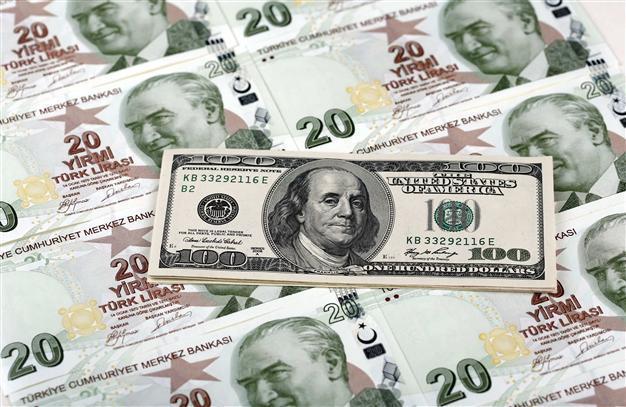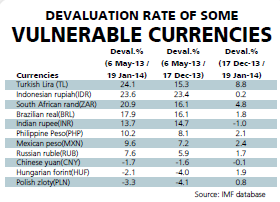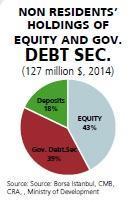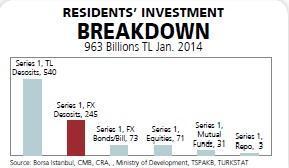No slowdown in foreign exchange rate’s climb after political crisis
MUSTAFA SÖNMEZ - mustafasnmz@hotmail.com

With the signaling of FED Chair Ben S Bernanke in May 2013 that the United States would reduce bond purchases and increase interest rates, foreign investors started turning their backs on a group of countries that includes Turkey. REUTERS photo
With the signaling of FED Chair Ben S Bernanke in May 2013 that the United States would reduce bond purchases and increase interest rates, foreign investors started turning their backs on a group of countries that includes Turkey.The political crisis that erupted especially after the Dec. 17, 2013, corruption investigations were immediately reflected in the economy. In the Turkish economy which already has fragile characteristics, the position foreign investors have taken and the drift toward foreign currency among those with domestic savings or debts have made the foreign exchange rate the barometer of the economy. Eyes are focused on the climb of the foreign exchange rate. Where is it going and when will stability come?
With the signaling of FED Chair Ben S. Bernanke in May 2013 that the United States would reduce bond purchases and increase interest rates, foreign investors started turning their backs on a group of countries that includes Turkey. With the decrease in the inflow of foreign currency by foreigners to these countries, local currencies – like the Turkish Lira – started losing value. While some countries tried to stop this by increasing interest rates, Turkey did not use the interest tool; instead of that, it sold $20 billion from the Central Bank’s foreign currency reserves in a bid to prevent the rapid erosion in the foreign exchange rate.
Second shock on lira
 Again, from May 2013 to Dec. 17, 2013, the loss of value in the lira reached 24 percent. The value loss in the lira went above the loss of local currencies in the most vulnerable countries. During the period in question, Turkey was in a league of its own in comparison to Indonesia, South Africa, Brazil and India, even though they also experienced significant losses in their currencies’ value.
Again, from May 2013 to Dec. 17, 2013, the loss of value in the lira reached 24 percent. The value loss in the lira went above the loss of local currencies in the most vulnerable countries. During the period in question, Turkey was in a league of its own in comparison to Indonesia, South Africa, Brazil and India, even though they also experienced significant losses in their currencies’ value.Different from other countries, a second shock hit the lira with the Dec. 17 earthquake and accelerated the loss in value. After Dec. 17, the lira’s loss against the dollar reached 9 percent in one month and one dollar became 2.25 liras. On the other hand, in these 30 days, the devaluation in the South African rand stayed at 4.8 percent while the fall in the Brazilian real did not exceed 2 percent. The Indonesian currency and the Indian money, however, have changed very little in the last 30 days. It is obvious that the political crisis has been the main factor in the lira’s rapid devaluation. While the increase in interest rates was a significant factor, especially in Brazil, in the decrease of the devaluation in the past one month, Turkey persistently did not use this weapon; there was no interest rate increase decision also in the Jan. 21 meeting.
 Foreigners
ForeignersAmong those waiting for a relaxation in the foreign exchange rate are foreigners who have invested in shares in the stock exchange and government bonds. Together with money that has been deposited in banks, the value of foreign investments this month is $127 billion. Foreigners have invested 43 percent in shares, 39 percent in government bonds and they have $23 billion dollars in bank accounts.
Watching for the most suitable dollar exchange rate to empty their portfolios, foreigners have not caught “that moment” yet. Foreigners have $54 billion investments in shares and $50 billion in government bonds. Foreigners who entered the bourse and invested in shares and in government bonds when the dollar was 1.70 – 1.80 liras, have been “jailed” inside against the rapid foreign exchange rate hike. If they attempt to exit now, then they will have to buy the dollar at 2.25 liras and will lose. It can be said that they are waiting for the exchange rate to calm down. Local investors, on the other hand, are predominantly focused on lira savings. As of Jan. 10, local savings amounted to 963 billion liras; 56 percent of the investments are in bank accounts. Foreign currency accounts constitute only 25 percent of the total. Just for now, of course… Investors, despite the lack of a satisfactory interest rate, have not taken a risk up until now, staying with the lira. The other 19 percent of the investments of the local investors are in fields such as shares, government bonds, investment funds and repo.
 Here, the question is whether or not the deposits in the lira (with 60 percent belong to real persons and 40 percent to legal persons) will stop contending with the crawling interest rates and head for foreign currency. Only one-fourths of the savings of local investors are in foreign currency now. Under circumstances where the interest rate does not move and loses its meaning before inflation, will the investor insist on staying in the lira? A portion of the corporate savings may continue to remain in the lira, but what about companies and real persons? It is obvious that any drift to foreign currency will push the exchange rate higher. Again, making a forecast for tomorrow calls for huge courage, because the issue has stopped being “economic” for a long time.
Here, the question is whether or not the deposits in the lira (with 60 percent belong to real persons and 40 percent to legal persons) will stop contending with the crawling interest rates and head for foreign currency. Only one-fourths of the savings of local investors are in foreign currency now. Under circumstances where the interest rate does not move and loses its meaning before inflation, will the investor insist on staying in the lira? A portion of the corporate savings may continue to remain in the lira, but what about companies and real persons? It is obvious that any drift to foreign currency will push the exchange rate higher. Again, making a forecast for tomorrow calls for huge courage, because the issue has stopped being “economic” for a long time. Unless the political crisis is overcome, it does not look like it will be easy for the parameters in the economy, especially the foreign exchange rate, to gain stability.
















